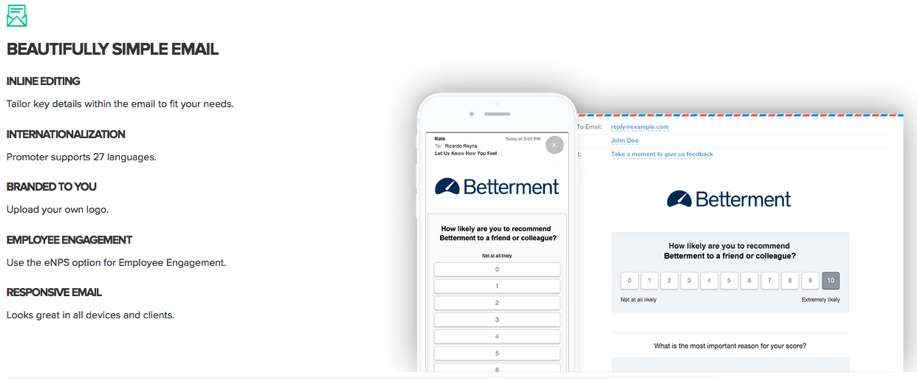Introduced in 2003 by management consulting firm Bain & Company, NPS stands for Net Promoter Score — a method for measuring the loyalty of each individual customer and gathering valuable feedback. If you are struggling to find a simple method for measuring the overall happiness and loyalty of your customers, the NPS may be just what you’re looking for.
The ultimate sign of a customer who loves what you do is one who doesn’t hesitate to recommend you to friends, family or a business associate. But prior to the introduction of the NPS data, companies were left with the prospect of creating complex customer surveys that were often left open to interpretation or worse yet, never filled out. Survey Monkey presents some interesting statistics:
- 20% of people claim to fill out less than half of an average survey
- Almost 30% of people only answer a few questions
- 45% of people are willing to spend less than 5 minutes filling out a survey
These types of statistics demonstrate the value of relying on a simple approach like that of NPS. While there are certainly times when gathering more complex data may be required, NPS can provide valuable insight into one of the most important metrics — overall customer satisfaction.
How to Capture and Calculate NPS Data

What makes NPS so popular and so useful is that it relies on a response to two simple questions:
- How likely are you to recommend our product/service to a friend?
- What is the most important reason for your score?
Because NPS relies on just two simple questions, the data is easy to capture, has a high response rate and most importantly, is relevant and actionable.
Most commonly, NPS data is captured from within a web application or via email. Many companies ask immediately following a customer interaction; for example, upon closing a support ticket, completing a purchase or interacting with a web application. However, other companies choose to send out NPS surveys on a regular schedule — once per quarter to all customers or even a small percentage (<2%) each day. A shorter feedback loop can provide more consistent and real-time data that can also be acted upon much faster.
There are a variety of ways in which you can collect NPS data. Promoter.io and AskNice.ly are two SaaS examples that offer a complete NPS service from initial emails to segmented campaigns to full-analytics. Alternatively, if you use InfusionSoft or another CRM, there are often pre-built campaigns available (or you could also develop your own) that will allow you to dive deeper into the minds of your customers.
How to Calculate Your Net Promoter Score
NPS relies on a scale that ranges from -100 to +100. A positive NPS score means your customer base is a net promoter and a negative score means that your customer base is net detractors.
Each customer is assigned a score (chosen by them) that ranges from 0-10:
- 0-6 are detractors
- 7-8 are considered passives
- 9-10 are considered promoters
To calculate your actual NPS score, you’ll need 3 numbers:
- The total number of respondents
- The total number of detractors
- The total number of promoters
Customers who answered 7 or 8, while positive overall, are not included in the calculation.
Once you have these three numbers, simply subtract the percentage of detractors from the percentage of promoters to arrive at the net score — the higher the number the better.
How to Utilize NPS Data
While collecting data is an important first step, what’s more important is how you act upon that data. Net Promoter Score is a great indicator of overall customer loyalty but you’re still left with the challenge of interpreting the data and figuring out how to improve your score over time. This is what makes the second part of the NPS question so valuable.
Companies like Zapier, Groove and Kissmetrics rely heavily on post-NPS follow-up to engage customers. But more importantly, they use the feedback to develop their roadmaps. For example, Kissmetrics records every suggestion they receive via the NPS survey and tracks the total requests/comments. They then use that data as a key contributor when developing their company roadmap.
Looking beyond the actual Net Promoter Score and longer term analytics, one of the most valuable aspects of the NPS is the opportunity it presents to build stronger relationships with customers. Companies who take the time to reach out to customers, whether they’re promoters, passives or detractors, are more likely to experience beneficial results.
NPS is an Opportunity Not a Number
Simplicity. It’s what makes NPS both popular and effective. However, it’s just a number. Unless you take action based on the data gathered, you are unlikely to see any benefits. Your final Net Promoter Score is more of a barometer than anything else. It provides an ongoing indication of how well you are meeting the needs of your customers and responding to their feedback. If you do nothing with the feedback, you’re likely to see your NPS decline.
When customers take the time to respond to your request for feedback, one of the best things you can do is use that opportunity to engage them further. Send a personal thank-you email to passive customers and promoters; thank detractors for their time and confirm your commitment to improving or offer them a few trial after you make some internal changes.
If you are currently using NPS to measure customer satisfaction, how do you feel it has benefited your company?
Image Credit: Pixabay
